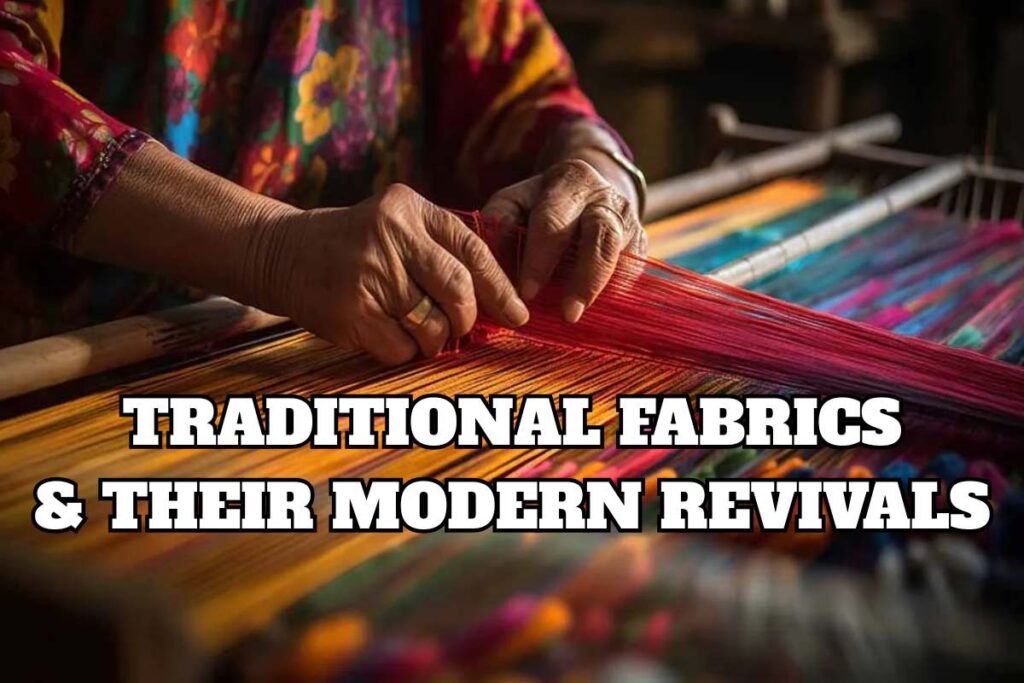The traditional fabrics are rich in history, arts, culture, unique styles and origins are made the modern revivals which are shows on Indian Khadi, Kanchiwaram, Patola and many more. On the other hand, Japan’s Sashiko also defines their cultural identity. These traditional fabrics embody centuries old wisdom in craftsmanship, sustainable practices and uses of natural fibers and dyes which provides sustainability. These fabrics are customized by the global designers and will be fast fashion so the main revivals of the Traditional Fabrics are authenticity, sustainability and ethical fashion.
Traditional Fabrics and Their Modern Revivals
The traditional fabrics are now changed with renaissance such as handmade crafts, digital revolutions and local initiatives aimed at preserving old age technologies. These traditional clothes are empowering the rural economics, empowering women and sustainable movements. India is rich in tradition and culture so the different states of India have different kinds of best and traditional clothes such as Pulkari of Punjab, Block print of Rajasthan, Chikankari of Lucknow and others. Nowadays, the digitalizations, new technologies and innovations are becoming their modern revivals.

Global Awakening Regarding The Traditional Fabrics
Through the modern revivals, the production will be increased so it also provides the global awakening of traditional fabrics. The global markets of Asia, Middle East and Europe will be providing the economical wealth and cultural exchange by the wide ranges of markets. By the traditional fabrics, the global market can easily get the new designs of the clothes which also provides the economical wealth. Nowadays, the demands of the traditional wear will be increased more so the traditional weavers of the clothes will be empowered economically.
Adoption Of The Traditional Fabrics Demands
In the international markets, there are lots of demands of the traditional fabrics such as Pulkari of Punjab, Block print of Rajasthan, Chikankari of Lucknow, Banarasi Silk Sarees of Uttar Pradesh, Kanjeevaram Silk Sarees From Tamilnadu etc. the demands of these traditional fabrics are increased by their subtle designs, rich traditional looks and unique patterns. The main reasons for the adoption of traditional fabrics are the online marketplaces, social media and e-commerce websites which allow the sale of these fabrics. These methods reduce the gap between the traditional artists and modern consumers.
How To Revive The Traditional Fabrics
The traditional fabrics are the most demanding products nowadays and some designers like Sabyasachi Mukherjee, Ritu Kumar, Anita Dongre are promoting this globally. The traditional weavers can also revive their products by digital strategies and marketing. The e-commerce websites are also helpful in increasing their sales and for marketing or promotions social media will provide the benefits. These involvements are also helpful in providing their wages into the next new generations.
Impact of The Technologies
The digital platforms are transforming the traditional fabrics demands and through the social media, this heritage will be passed to the next generations. The new technologies and innovations improve productivity and the traditional weavers can also get the help. The new traditional products will be in demand in other Asian countries, Europe etc. with the help of the new technologies, it increased the incomes and empowered the women of India or traditional weavers.
FAQs On The Traditional Fabrics and Their Modern Revivals
The main revivals of traditional fabrics’ modern revivals are sustainability, artisan supports and digitalizations.
Yes, the next generations adopt the traditional fabrics after the digitalizations.
The main challenge of the traditional clothes are economical factors, skill transfers and transferring the skills to the next generations.
